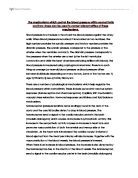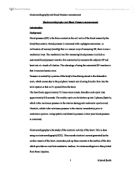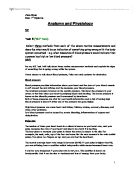Baroreceptors are mechanoreceptors that respond to stretch, and they are found in the tunica adventitia layer of arteries in two locations. In the aorta, the baroreceptors are found around the transverse arch of the aorta, and their stimuli travel into the vagus nerve. The carotid sinus is a dilatation of the common carotid artery, at the point where it branches into the internal and external carotid arteries, and the stimuli from the fine carotid sinus nerve ascend into the IXth cranial nerve.
Arterial distension is associated with a rise in arterial pressure, and this excites the baroreceptors. The response to stretch is enhanced in the carotid sinus, due to the comparative thinness of the tunica media, and even during a normal pulse pressure, there is approximately a 15% change in diameter. Under normal conditions, the baroreceptors fire repeated impulses, but these increase in frequency in conditions of stretch.
The baroreceptor nerve fibre has a threshold pressure below which it does not fire, and it also responds over a limited range of pressures. In the nerves, there are two main classes of fibres. Myelinated fibres have thresholds at 50-60 mm Hg, and have a saturated response at 80-100 mm Hg, whilst the non-myelinated C fibres have higher thresholds of over 80 mm Hg.
Due to the different types of nerve fibres, as blood pressure rises, different fibres are recruited, allowing for a range of blood pressures of 60-100 mm Hg to be covered. The carotid sinus receptors have lower thresholds and greater sensitivities than the receptors in the aortic arch.
Arterial Baroreceptors Depressor Response
- Decreases vasoconstriction
- Decreases venomotor tone
- Decreases heart rate
- Decreases contractile force
Experimentally, a fall in pressure produces tachycardia and an increased myocardial contractile force, which is mediated by an increase in sympathetic activity and reduced vagal tone. Peripheral resistance is increased by causing vasoconstriction in the splanchnic and renal circulations; this also displaces blood into the central veins, thus enhancing stroke volume via the Frank-Starling mechanism. Adrenaline is secreted in response to increased splanchnic nerve activity.
Cardiopulmonary receptors are classified into three types – atrial and vena caval, ventricular, and pulmonary. These receptors sense blood volume in the low-pressure central compartment of the cardiovascular system, and are important in adjusting the skeletal muscle bed in response to a decrease in blood volume, and in the control of extracellular fluid.
The arterial pressure is the product of the cardiac output and the peripheral resistance, so is therefore affected by a change in either or both of these two factors. Generally, an increase in peripheral resistance will increase the diastolic pressure, whilst an increase in systolic pressure will be caused by an increase in cardiac output. Arterial blood pressure rises with age, and an important cause in the increase in systolic blood pressure (which rises more) is the decreased elasticity of the walls of the arteries as they become more rigid. This means that at the same level of cardiac output, the systolic pressure is greater due to a lower increase in the volume of the arterial system during systole, which needs to accommodate the same volume of blood.
In exercise involving mainly isometric muscle contraction, the heart rate rises, followed by sharp increase in systolic and diastolic blood pressure. Stroke volume changes relatively little, and there is reduced blood flow to the steadily contracting muscle as a result of compression of the blood vessels.
Surprisingly, during isotonic muscle contraction, systolic blood pressure rises only moderately, and diastolic blood pressure may remain unchanged or fall. There is an increase in both heart rate and stroke volume, but in the exercising muscles, vasodilation occurs. This decreases the peripheral resistance, opposing the effect of the changes in heart rate and stroke volume.
After exercise, blood pressure may drop to subnormal levels, and this is thought to be due to accumulated metabolites keeping the muscle vessels dilated for a short period. As these are removed, the blood pressure begins to return to its pre-exercise level. The heart rate returns to the pre-exercise level more slowly.
Haemorrhage causes a decrease in the circulating blood volume, which affects blood pressure. Venous return is decreased, and cardiac output falls, though heart rate increases. The decrease in the rate of nervous signals from the baroreceptors results in tachycardia and vasoconstriction, though this does not occur in the vessels of the brain and heart.
Extrinsic reflexes originate outside the circulatory system, and evoke responses via somatic afferent pathways. Normally, these reflexes play a minor role, and are secondary to the intrinsic reflexes. Pain is one extrinsic reflex, but the responses to this can be variable. Severe pain can induce bradycardia (slowing of the heart rate), hypotension, fainting and circulatory collapse. Cold is another stimulus that can affect the blood pressure, increasing coronary artery resistance, and in patients with coronary artery disease, it can precipitate angina.
The arterial blood volume is one factor affecting arterial blood pressure. As the blood flows through the arteries, the walls exert a pressure back on the contained blood due to the elastance of the vessels. The arterial pressure is altered continuously by changes in the heart rate, the peripheral resistance and stroke volume. Long term changes can also occur due to changes in the unstressed resting volume (this is when the internal pressure equals the external pressure), or by changes in the elastance of the artery walls.
Increasing the heart rate will increase the arterial volume and therefore pressure, because this means that the time it takes the blood to complete the cardiac cycle is reduced. In addition to this factor, the cardiac output will usually increase. Eventually, the pressure stops rising because there is equilibration, as the blood entering the arterial system equals the blood leaving the system.
When peripheral resistance increases, the arterial blood volume is increased because less blood leaves the arterial system. This will again increase the arterial blood pressure, until the pressure becomes enough to overcome the additional resistance. Increased stroke volume and increased elastic content of the artery walls also raises the pressure.
Along with decreasing stroke volume, heart rate, peripheral resistance, and the elastic content, haemorrhaging and blood pooling will decrease the blood pressure by reducing the circulating blood volume.







